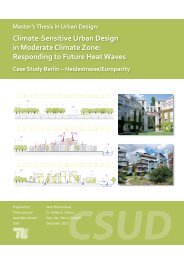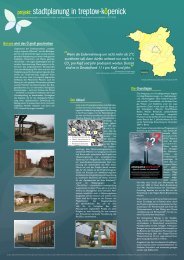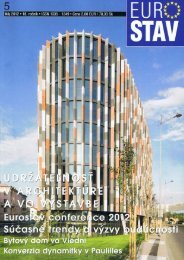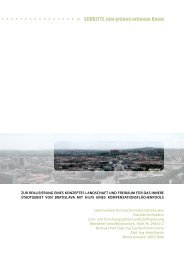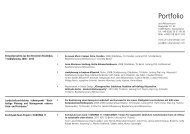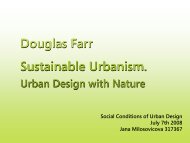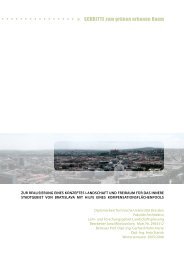Bausteine - Referate - Jana Milosovicova - Urban Design English
Bausteine - Referate - Jana Milosovicova - Urban Design English
Bausteine - Referate - Jana Milosovicova - Urban Design English
Sie wollen auch ein ePaper? Erhöhen Sie die Reichweite Ihrer Titel.
YUMPU macht aus Druck-PDFs automatisch weboptimierte ePaper, die Google liebt.
Sustainable neighborhood rating systems: An international comparison<br />
Die Bewertungsmatrix<br />
of international core criteria for sustainable<br />
neighborhoods. While the list can be rearranged<br />
or reordered, the goals are appropriate for<br />
any new neighborhood. What is also important<br />
about this analysis is the opportunity to see how<br />
two rating systems have evaluated the same issue.<br />
Despite the size advantage of LEED-ND, it<br />
can learn from the Assessment Matrix criteria<br />
that tend to have higher but more general criteria.<br />
Similarly, if the Assessment Matrix wants to<br />
move toward a certification model, LEED-ND<br />
has a high level of rigor in their standards. When<br />
sustainable neighborhood rating systems are revised<br />
in the future or if new systems are created,<br />
alternative criteria options are provided in the<br />
detailed comparison (see Appendix 1).<br />
in Germany and therefore makes little sense to<br />
reward the current system. Each country needs<br />
a system that caters to its circumstances. German<br />
transit standards need to be higher than<br />
American standards, otherwise there wouldn’t<br />
be an incentive to improve anything in Germany.<br />
Regional differences within the U.S. and to a<br />
lesser extent within Germany may need to be<br />
considered in a similar manner. Finally, while the<br />
reduced auto use credits may offer flexibility<br />
within the rating system for cities that do not<br />
have transit, it is still not a substitute for offering<br />
other modes of travel.<br />
Best Practice Ideas<br />
Similar Issues, Different Standards<br />
Some issues in this evaluation are similar, but<br />
may be need to be based on national standards<br />
for the purposes of evaluation. These standards<br />
may include energy and water efficiency<br />
or affordable housing, where criteria are best<br />
tailored to national programs or accreditation<br />
organizations.<br />
Unique Problems<br />
There are many problems addressed by LEED-<br />
ND that are unique to the U.S. and would not<br />
be appropriate to evaluate in a German context<br />
since they are not problems worthy of evaluation.<br />
These include the requirement for using<br />
city water and sewer which is standard practice<br />
in Germany. Similarly, Germany does not<br />
have gated communities, so prohibiting them<br />
also is not relevant. Site erosion during construction,<br />
while common to find on an American<br />
construction site, is also rare in Germany. The<br />
reduction of auto travel relative to the metropolitan<br />
area that LEED-ND offers as a substitute<br />
for the transit credit (for municipalities<br />
that do not have transit), also makes little sense<br />
in Germany where all but the smallest towns<br />
have mass transit. Providing bus stop shelters<br />
and route information is also standard practice<br />
One of the strongest concepts to emerge from<br />
this analysis is “Reachability.” This word – a direct<br />
translation from the German “Erreichbarkeit” –<br />
refers to the ability for people to reach their destinations.<br />
While not a common planning term<br />
in <strong>English</strong>, it appropriately expresses the needed<br />
relationship between land use and transportation.<br />
The Assessment Matrix does a better job<br />
analyzing this concept than LEED-ND, considering<br />
eco-mobility options for walking, bicycling<br />
or transit and how it connects people to where<br />
they need to go: work, school, grocery shopping<br />
or a soccer game.<br />
Achieving Climate Change Results<br />
A study at the relationship between LEED-ND<br />
pilot projects and climate change impacts has<br />
been completed. The results show that pilot<br />
projects have increased density, increased transit<br />
commute share and increased walking/bicycling<br />
commute share than average U.S. communities,<br />
which could lead to potential CO2 savings. (Criterion<br />
Planners, 2007) Given these results, encouraging<br />
more development to follow LEED-<br />
ND could reduce CO2 emissions from vehicle<br />
travel. Similarly, as worldwide standards for sustainable<br />
neighborhood rating systems evolve,<br />
they can also provide measureable goals that<br />
will reduce the threat of climate change.<br />
110



